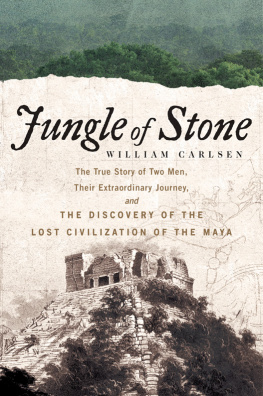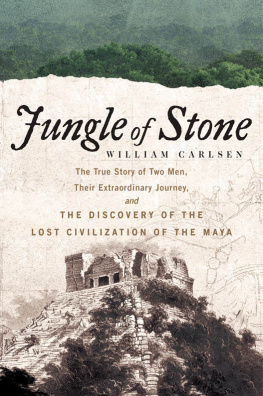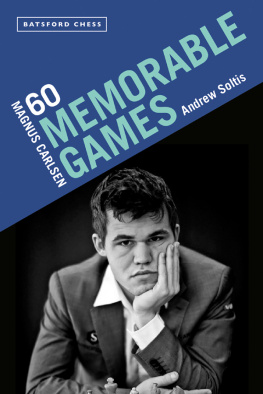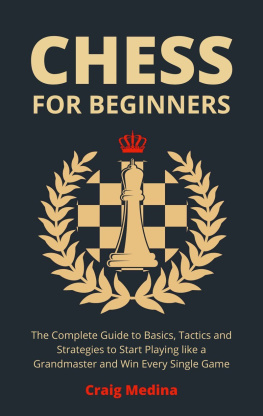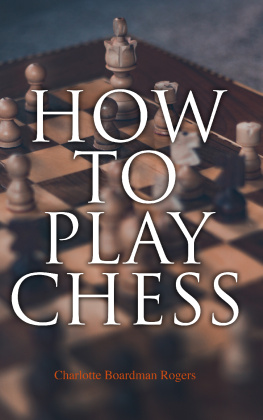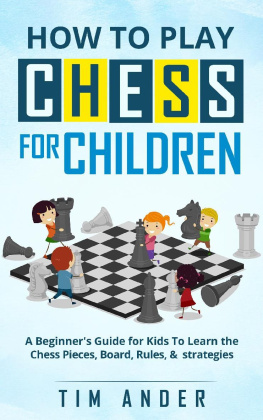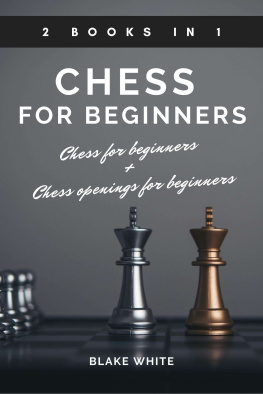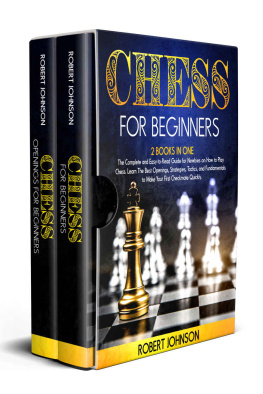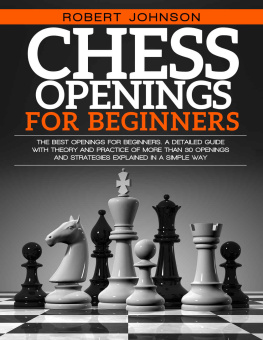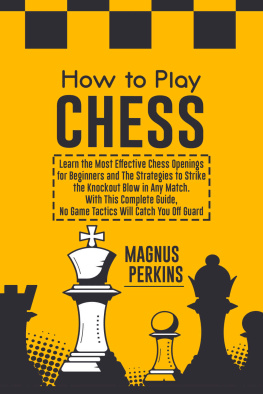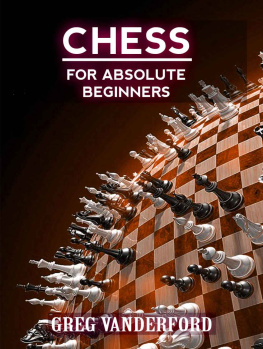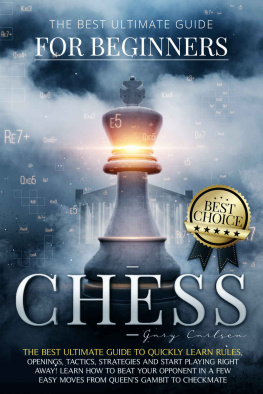CHESS FOR BEGINNERS
A COMPLETE GUIDE TO LEADING YOU TO VICTORY! CHESS FUNDAMENTALS, RULES, STRATEGIES AND SECRETS FOR THE SUCCESS OF EVERY GAME
Table of Contents
Introduction
If youre reading this guide, youve probably been drawn to the game just like the rest of us. Thats understandable, chess is a pastime that can be as deep or shallow as you want. You could end up devoting as little time as a game or two a week, or become an avid player engaging in multiple games per day. A few ends up committing most of their lives to the game, but however much you put into chess, youll always get a return on your investment.
What is it that makes chess so appealing to so many people? The answer may vary depending on who you ask. Some find it to be a calming hobby, a chance to shut out the noise of the outside world and lose oneself in the infinite depth of the game. For others, its a breakneck competitive outlet and an opportunity to feel the rush of personal improvement. No matter who you are or why you play, however, understanding the fundamentals of the game is a sure way to enhance your experience. Just as in any kind of art, sport, or craft, a trained eye is capable of interpreting and enjoying more details in every aspect of the hobby.
Thats where Chess for Beginners comes in. With this book in hand, you will be gaining a valuable head-start into understanding the many intricacies of chess. As you read on from the games storied history to its evolving modern strategies, youll come to fully understand why this game of 32 pieces and 64 squares continues to fascinate people and cultures all over the world.
History of the Game
The precise origins of chess remain a mystery, with historians and anthropologists still debating over the subject. Whats generally agreed, however, is that the earliest known ancestor of the game originated in India sometime before the 6 th century CE. This early predecessor, called chaturanga , was quite different from the game we know today. A war game, chaturanga took its name from a military formation mentioned in the epic Mahabharata . The formation itself refers to four divisions within the army: infantry, cavalry, chariotry, and elephantry.
As chaturanga evolved, so did the names it was known by. Around 600 CE, chatrang became a growing pastime in Persia and Central Asia where it later spread to further east, gaining recognition with different cultures, calling it different names. In Mongolia, it was called shatar , in China, xiangqi , and in Japan, shogi . Each culture brought its unique perspective to the rules of the game and the character of the pieces, but two fundamental qualities of chaturanga persisted in each variation. First, unlike in checkers, different pieces had different capabilities. Second, capturing the opponents king was the path to victory. These qualities remain fundamental to the DNA of modern chess.
Chess reached Europe by the 10 th century CE by way of expanding the Islamic Empire. When chatrang was introduced to the Arab world, it was redubbed shatranj but remained largely similar to the Persian variation of the game.
The early Islamic conquests brought bloodshed to both the Levant and the Iberian Peninsula but also brought cultural and technological innovations, including shatranj . The Greeks called it zatrikion , while in Spain, it became known as ajedrez . Both cultures initially retained the Persian names given to each piece. As the game spread throughout the medieval world, the Persian word shh (king) gradually evolved into the English chess . The phrase Shh Mt! (the king is helpless) would likewise develop into the modern term checkmate .
Chess quickly took the European world by storm as it became so popular that at times both the church and secular authorities attempted to prohibit the gamesand the gambling that often came with it. Eventually, the names of the pieces began to change to reflect the local culture. Elephants became bishops and the vazr , or minister, became the queen.
The rules of the game continued to change as well. By 1300, an addition had been made to the rules, allowing pawns to move two squares on their first move. Later, sometime before 1500, the previously weak queen and bishops gained new abilities to make them more useful and to speed up play. This modified ruleset, once referred to as Queens Chess, developed into the modern standard of play by the 19 th century.
Since the birth of modern competitive chess in 1851, when German-born Adolf Anderssen won the first-ever international chess tournament, the sport has exploded into a worldwide phenomenon. Countless grandmasters, men, and women hailing from dozens of countries around the world have risen to prominence throughout the decades.
In the late 20 th Century, chess even became a topic of a heated political conversation. When the 1972 World Chess Championship pitted American prodigy Bobby Fischer against Russian champion Boris Spassky, both of the rival nations took immense interest in the matchs outcome. When Fischer won the match, ending 24 years of Soviet dominance in competitive play, it was touted as a blow against the USSR itself. Later, when Fischer defied U.S. sanctions to attend an unofficial rematch against Spassky in 1992, a warrant was issued for his arrest.
Today, the Fdration Internationale des checs (FIDE) acts as the governing body of competitive chess worldwide. New names have come to prominence in recent years, including Hungarys Judit Polgar, widely considered as the strongest female player in the history of the game. The current reigning champion, Magnus Carlsen of Norway, holds the highest peak classical rating in history with a score of 2882.
Using This Guide
The purpose of this book is to introduce new players to the game: its mechanics, strategies, and the joys of playing. Its meant for both brand-new players and those with some knowledge who are looking to deepen their understanding.
We recommend that you read each section sequentially from start to finish. While all terms are outlined when they first appear, you can circle back to the glossary at the end of this book for a quick refresher. Otherwise, the book makes the most sense when each chapter is read in order.
You will familiarize yourself with how to read algebraic chess notation and learn how to read diagrams. Youll also learn the movement options for each piece, as well as a brief overview of the common strategic uses of each piece. Finally, youll receive an overview of standard piece values as determined by a majority of strategists.
With this knowledge in hand, you will then progress to Chapter 2: The Goal in Chess .
Finally, in Chapter 3: Tactics to Support Your Strategies chess club or get started playing online, the closing section of this guide provides further study tools as you grow into a more advanced player. From reading lists to databases, theres an endless, ever-growing selection of chess knowledge out there, just waiting to be studied.
So, lets get started. Today, you will be taking what may as well be your very first steps as a chess player. Someday, with dedication and continuous study, you might find yourself writing the next great book on chess! Its your path to pave, and whether youre just looking for a fun new hobby or already have your sights set on grandmaster status, this guide is here to help.
Chapter 1. Foundations and Rules of Chess
Explanation of Chess Pieces
Pawn
Derived from the word Pawnee who were famous warriors and hunters of the vast wilderness. Such warriors were recognized by the Sioux and was described aptly by the Cheyenne as The Huntsmen of the Plains.
The pawn is one of the most unusual pieces on the board because of the way it moves and captures pieces. Many people see the pawn as an inconsequential piece but, when used correctly, it can be one of the strongest pieces you have in your army. Pawns can only move one square at a time except for their very first move when they can go two squares. To capture another piece, the pawn has to do so diagonally, never forwards, backward or sideways. If the pawn is blocked by another piece in front, it cannot move past it nor can it take it.




